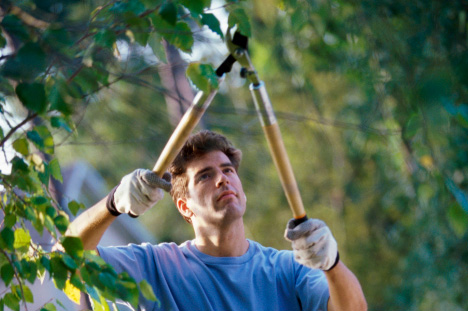Living Green Magazine –

Trees are the most prominent component of most home landscapes. They add aesthetic and financial value, and they can help control energy costs as well. But having trees in the landscape isn’t as simple as just digging a hole and dropping a seedling into it.
Trees require some upkeep, and some of the most important tips to maintaining your tree involve the many ways that good pruning can help your trees.
Disease Management
A wide array of diseases can strike your tree. While foliar problems like anthracnose typically infect the entire tree, others like fire blight are confined to random branches on the tree. Because these conditions aren’t reversible once they become active, a frequent treatment is to limit spread by cutting out infected areas.
But good pruning also helps prevent diseases. Wet, fast-growing plant foliage is a perfect environment for fungal diseases to thrive. Air movement and sunlight exposure are key ways of drying foliage, and pruning to favor those two factors is the best way to improve them.
It’s also helpful to other plants in your landscape when you prune your trees. Removing the lower limbs makes mowing easier and permits more sunlight for grass, reducing weeds and moss. The air movement and sunlight penetration taking place high in your tree will also take place in your understory shrubs, bushes, and other plants, helping prevent diseases in areas far beyond the tree.
Break Prevention
Trees aren’t always the best planners. They sometimes create limbs that don’t necessarily go the best direction for structural stability. In time, these limbs get longer and heavier, creating a potentially delicate imbalance that can allow the wind to break limbs out of the tree. That leads to the potential for more than just an ugly tree; falling limbs can damage property and injure people.
An experienced home landscaper can identify these bad-news branches and remove them before they become large enough to create a hazard. If you have any concerns about particular limbs, consider seeking advice from a qualified arborist before taking action. Remember, you can always cut the limb later, but you can never put it back.
Just Plain Beauty
While we’re on the topic of out-of-place branches, we should think about the overall shape of our trees. Each species has its own unique silhouette. Oaks are round and full, whereas maples take on more of an arrowhead shape. Sometimes environmental factors, damaged limbs, and other outside forces can pull a tree out of its normal shape. In those cases, sometimes the judicious removal of a few errant limbs can begin to restore a more appropriate shape.
The Cardinal Sin
Whatever pruning a tree may need along its trunk, it never should be topped. Removing the top branches of any tree creates a wide variety of problems. First of all, this creates an imbalance in the top of the tree that can encourage splits high up in the tree later on. Also, the tree reacts to limb loss in this area by quickly forming soft, fast-growing water sprouts that have little ability to resist disease and insect invasion. And finally, the pruning wounds in a topped tree are facing upward, meaning they cannot heal properly due to exposure to sunlight and wind. These open wounds are an ideal invasion point for insects and diseases.
The post Proper Tree Pruning Benefits The Whole Landscape appeared first on Living Green Magazine.
(c) Living Green Magazine – Read entire story here.